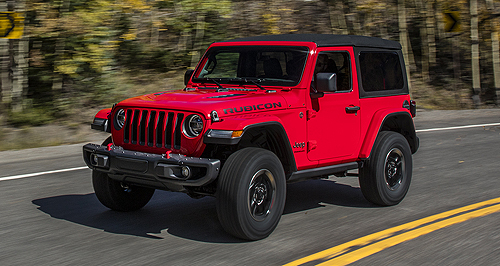Make / Model Search
News - JeepElectrification on the horizon for Jeep AustraliaFresh air: Jeep’s electric future could take a while to arrive in Australia as the local market adoption of alternative powertrains remains low. High cost and no infrastructure cited as hurdles for electrified Jeeps to overcome5 Sep 2018 By TUNG NGUYEN JEEP Australia will wait until market readiness before introducing its plug-in hybrid and full electric vehicles despite a ramp up in its global portfolio that will see alternative powertrains proliferate across its model range over the next five years.
Announced in early June at an investor meeting, then Fiat Chrysler Automobiles (FCA) chief operating officer Sergio Marchionne revealed Jeep’s ambitions to offer at least one electrified variant of each of his models by 2021, while 10 plug-in hybrid electric vehicles (PHEVs) and four emissions-free SUVs will be made available the following year.
However, FCA Australia president and chief executive, as well as head of the Jeep brand for the Asia-Pacific region, Steve Zanlunghi exclusively told GoAuto that electrified Jeeps will only be made available locally once the alternative powertrains reach critical mass.
“I think if the market dictated it, then yeah, we can bring (in electrified Jeeps),” he said. “The electric powertrain applications exist in our portfolio, we can plug it in and bring it here if we wanted to.
“(But) right now, there is no demand in this marketplace. If you look at the figures, there was something like 760 electric vehicles, pure electric, registered so far this year, versus an industry of 680,000?
“So I don’t see it.”
Year to date, EVs have only made up 0.1 per cent of all new-car sales, although hybrid adoption has reached 7610 units this year for a 1.1 per cent cut through.
Mr Zanlunghi revealed multiple reasons for why electrified powertrains have not caught on, such as a lack of public charging stations and the comparatively high point of entry, but stopped short of calling for financial incentives from government.
“Those powertrain applications are very expensive, and then you get the infrastructure as well,” he said. “
“Those powertrain applications cost thousands of dollars more than your traditional combustion engines and powertrains. I guess my point is, if there was a demand for it, or if there was government regulation that came down and said ‘either you’re taxed if you don’t have it’ … then we can easily plug it in, because it’s part of the strategy.
“It is not cheap, and customers do not want to pay it right now. Not just here but even in Europe, adding thousands of dollars, but like I said, it’s there, and the government’s pushing it, and they also supply subsidies, but can use the infrastructures there as well.”
Jeep has already begun gearing up for electric powertrain production, last month retooling its Toledo, Ohio machining plant to manufacture the vital Power Electronics Module for the new-generation Wrangler – likely to the brand’s first electrified model.
When questioned if electrification would take away from Jeep’s go-anywhere, rugged brand image, Mr Zanlunghi said “absolutely not” and that the low-end torque would help its off roaders.
As for the leadership change at FCA that saw Mike Manley taking the reins from Mr Marchionne who passed away in July, Mr Zanlunghi said it would be business as usual.
“Mike has said on numerous occasions and interviews that he values the Australian market and the potential specifically for the Jeep brand here because our DNAs for our brand match up with the Australian culture and lifestyle,” he said.
“I don’t think there isn’t anything he wouldn’t have done previously that he would do now just because he’s the CEO, I don’t think for the Australian market.
“I think it’s up to myself as the head of the market and also the head of the region, to make proposals and business cases for the market here, and I think he would continue to make the decisions.”  Read more |
Click to shareJeep articlesResearch Jeep Motor industry news |












Facebook Twitter Instagram